Discovering Robert E Howard: Fred Adams Jr. on Esau Cairn – A Man Outside His Epoch
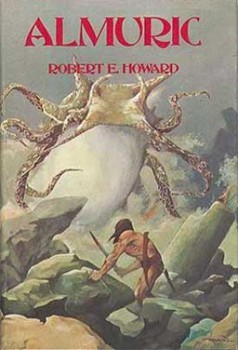 As you can see from the list of prior essays in this series down below, we’ve wandered all over the Robert E. Howard landscape. But we hadn’t touched on Howard’s science fiction. Dr. Fred Adams goes off-planet for us and examines one of Howard’s cult classics, Almuric. Blasting off…
As you can see from the list of prior essays in this series down below, we’ve wandered all over the Robert E. Howard landscape. But we hadn’t touched on Howard’s science fiction. Dr. Fred Adams goes off-planet for us and examines one of Howard’s cult classics, Almuric. Blasting off…
In his novel Almuric, published in Weird Tales in 1939, Robert E. Howard presents a one-shot protagonist named Esau Cairn, a man in many ways typical of Howard’s barbarian warrior-heroes, but who departs from them in that he is more philosophical than most of Howard’s creations, and perhaps in many ways best speaks to Howard’s personality and philosophy.
Much of the discussion of Esau Cairn and of Almuric hinges on what I call the WWCD? Issue: ‘What Would Conan Do?’ in the modern world. That topic has been exhaustively covered by the discussion threads of the Robert E. Howard Society, and several interpretations have been postulated. To me, the importance of Esau Cairn as a character is that he gives voice to Howard’s own frustration at being a man of action trapped in a relatively genteel world.
Howard wrote, in “The Tower of the Elephant,” “Civilized men are more discourteous than savages because they know they can be impolite without having their skulls split, as a general thing.” Cairn bears out that rule when his barbarism rises to the surface and he kills a corrupt politician (perhaps rightfully so) with a single blow to the head.
Pursued by the police, Cairn arrives at the observatory of a Professor Hildebrand, the frame narrator for Cairn’s story. The Professor offers Cairn an alternative to imprisonment or execution: a new life on a far planet we later learn is named Almuric. This is to be achieved by a process called the “Great Secret” by Hildebrand, as Howard deftly sidesteps the need for scientific explanation.
Professor Hildebrand describes Cairn as a man born “out of his epoch.” His superior strength and ability far outstrip those of contemporary men, and life around him is dangerous, as opponents on the football field and in the boxing ring quickly learned. Besides his physical prowess, Cairn exhibits the temper of the barbarian, which gets him into difficulty, though rightfully, Cairn is not to blame; he simply follows his nature.
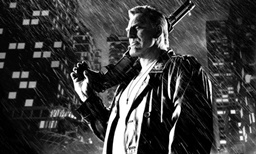 As the character Dwight muses in the film Sin City about a kindred spirit, Marv, “Most people think [he] is crazy. He just had the rotten luck of being born in the wrong century. He’d be right at home on some ancient battlefield swinging an axe into somebody’s face. Or in a Roman arena, taking his sword to other gladiators like him”: so too Howard’s feeling of being an outsider, a misfit in the modern world.
As the character Dwight muses in the film Sin City about a kindred spirit, Marv, “Most people think [he] is crazy. He just had the rotten luck of being born in the wrong century. He’d be right at home on some ancient battlefield swinging an axe into somebody’s face. Or in a Roman arena, taking his sword to other gladiators like him”: so too Howard’s feeling of being an outsider, a misfit in the modern world.
To a man like Robert E. Howard, Easu Cairn’s transportation “to a form of life wild and strenuous enough to satisfy his cravings, born in the dim red days of the world’s youth,” represents the ultimate fantasy.
Cairn appears on the new planet naked surrounded by hostile natives, deadly predators, and inimical climate. He survives on his own and becomes even stronger and more resilient than he was on Earth. He proves himself fit for this dangerous world, true to the archetype of the hero who is separated and stands on his own against all trials.
In his revolutionary book The American Adam, R. W. B. Lewis suggests that the American hero, particularly in the 19th century, is metaphorically a “new Adam” on the American continent, an innocent alone in a new garden, a new paradise. Howard would have scoffed at the notion.
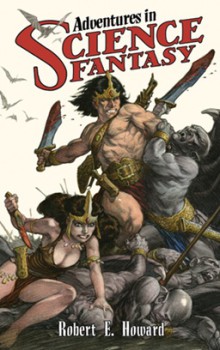 Howard wrote, in a letter to H. P. Lovecraft”
Howard wrote, in a letter to H. P. Lovecraft”
I have no idyllic view of barbarism — as near as I can learn it’s a grim, bloody, ferocious and loveless condition. I have no patience with the depiction of the barbarian of any race as a stately, god-like child of Nature, endowed with strange wisdom and speaking in measured and sonorous phrases. Bah! My conception of a barbarian is very different.
Howard turns the “new Adam” metaphor on its head in Almuric by placing Esau Cairn naked on an entirely hostile world, which to some would seem a living hell, a thicket of thorns. To Cairn it is a paradise of new challenges suitable for a man of his mettle.
The first-person narration allows the reader to see into Cairn’s mind and through it, into Howard’s. Cairn tells of his adventures on his new world, but also gives us a glimpse into his psyche, commenting on his nature, the nature of violence, and the nature of Man. We see a personal philosophy emerge that is absent from the Conan stories, told in an objective third person. Cairn is intelligent beyond the feral cunning of a hero like Conan. Cairn was intelligent enough to be accepted into college, although he withdrew before graduation. Cairn’s narrative includes introspective thoughts, something we do not find often in Conan.
For example, we would never find Conan musing over the origin of a species like the Yaga; he would have simply regarded them as foes. Cairn, on the other hand, speculates, “I believe they represented a branch on the tree of evolution, and that it is only an incredible freak of coincidence which cast them in a mold so similar to man…”
Howard uses a number of motifs to portray him as a unique character. For example, Esau Cairn’s pair of names provide familiar allusions. His surname Cairn calls to mind a pile of stones, especially a burial mound, a grim image suitable for a man who has died to the world of humans and been reborn on Almuric.
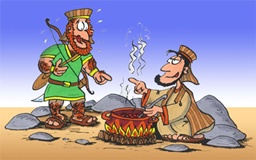 His Christian name (although Howard would likely snort at the implication), Esau, is Biblical, the name of Jacob’s fraternal twin, described as “red and hairy” in the King James Version. Howard never says specifically that Cairn has red hair, although most artist renderings of him show him thus. As for being hirsute, the relative hairlessness of his body makes Cairn an oddity among the Gura tribesmen, who are ape-like and covered in dark hair.
His Christian name (although Howard would likely snort at the implication), Esau, is Biblical, the name of Jacob’s fraternal twin, described as “red and hairy” in the King James Version. Howard never says specifically that Cairn has red hair, although most artist renderings of him show him thus. As for being hirsute, the relative hairlessness of his body makes Cairn an oddity among the Gura tribesmen, who are ape-like and covered in dark hair.
When Cairn shaves off the shaggy beard that has grown during his time in the wilderness, it is reminiscent of the shaving of Enkidu, the beast-man in the Sumerian epic Gilgamesh and his preparation to be integrated into society. Cairn shaves off his growth and proceeds to the company of men.
The Gura are shaggy and dark, and the females are smooth and fair-skinned. When he is first encountered and captured, Cairn is regarded as a curiosity, but none of the Gura males speak of him as effeminate, likely because of his musculature and his fierceness.
Like most archetypal heroes, Cairn is an outsider who comes from far away, and in traditional fashion, endures trials on his own, proving his mettle before he joins a tribe. That he has survived alone, like Enkidu, among the beasts of the forest earns him admiration and high regard from the Gura, to whom he represents a kindred spirit at the same time he is a curiosity. Cairn fits well in the Gura society, hunting, drinking, and brawling with the most barbaric of the tribe and earning their respect for his prowess.
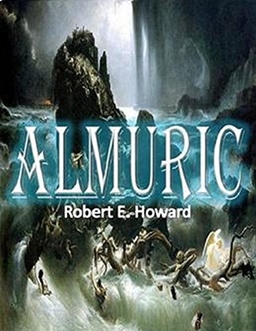 Howard symbolically bridges the male and female halves of the psyche in a Jungian archetypal fashion, something unique among males on Almiuric. Likewise, his approach to women. The Gura men are harsh and dominating, but Cairn does not subscribe to their ethos.
Howard symbolically bridges the male and female halves of the psyche in a Jungian archetypal fashion, something unique among males on Almiuric. Likewise, his approach to women. The Gura men are harsh and dominating, but Cairn does not subscribe to their ethos.
Altha says, “Why do they call you Ironhand? Your fingers are hard, but your touch is as gentle as a woman’s,” Cairn’s reply: “It’s the feeling behind the hand… No man I ever fought complained that my fists were gentle.” Unlike his brutish Gura fellows, Cairn has a capacity for tenderness, showing Altha the palm of his hand rather than his knuckles.
On another front, Howard’s portrayal of Cairn resonates with Lee Child’s contemporary loner-protagonist Jack Reacher : “Eat when you can because you never know when the next chance will be,” and, “Sleep when you can so you won’t need to when you can’t.” Cairn’s version: “Eat quickly, drink quickly, sleep lightly, and linger not over anything — those are the first rules of the wild, and his life is not long who fails to observe them.” It is the code of the beast, Tennyson’s “nature red in tooth and claw” adapted and articulated by a sentient being.
Yet despite what Cairn describes as his evolution from savagery to barbarism, he retains a vestige of humanity as evidenced by his statement concerning the evil of the winged Yaga and their debased ancient civilization:
The butchery of men I can endure, in battle, even in red massacre. The wanton slaughter of helpless women who can only shriek for mercy until the knife silences their wails, that is more than I can stand.
True to the archetype of the hero, Cairn resists the evil seductress in the form of nine-hundred-year-old Yasmeena, the winged black Yaga queen. He feigns drunkenness to avoid her advances, overhear her plans, and learn both his means of escape and his means of invasion when he returns.
Cairn also exhibits the archetypal heroic trait of self sacrifice when he risks his life to kill the doomsday beast that Yasmeena looses when she sees that the tide of the battle is going against her. Cairn and the beast fall five hundred feet into a river. The beast dies, but Cairn is pulled unconscious from the water by one of his comrades and again cheats death.
The defeat of the sybaritic Yaga at the hands of Cairn and the combined tribes of ape-men not only presents a classic triumph of good over evil; it echoes the fall of the decadent Roman Empire. As Howard has written, “Barbarianism [sic] is the natural state of mankind, Civilization is unnatural. It is the whim of circumstance. And Barbarianism must ultimately triumph.”
When one ponders Robert E. Howard, a barbarian spirit captive in a world softened by civilization and bound by its constraints, it is easy to understand how Almuric and Esau Cairn blossomed in his imagination.
Prior posts in our ‘Discovering Robert E. Howard’ series:
REH Goes Hard Boiled by Bob Byrne
The Fists of Robert E. Howard by Paul Bishop
2015 Howard Days by Damon Sasser
Solomon Kane by Frank Schindiler
REH in the Comics – Beyond Barbarians by Bobby Derie
Rogues in the House by Wally Conger
By Crom – Are Conan Pastiches Official? by Bob Byrne
The Worldbuilding of REH by Jeffrey Shanks
Re-reading ‘The Phoenix on the Sword” by Howard Andrew Jones & Bill Ward
Ramblings on REH by Bob Byrne
Pigeons From Hell by Don Herron
Re-reading “The Tower of the Elephant” by Howard Andrew Jones & Bill Ward
El Borak by David Hardy
Westerns by James Reasoner
Re-reading “Queen of the Black Coast” by Howard Andrew Jones & Bill Ward
Re-reading “Black Colossus” by Howard Andrew Jones & Bill Ward
Armies of the Hyborian Age by Morgan Holmes
Howard’s Influence on The World of Xoth by Morten Braten
Re-reading “Rogues in the House” by Howard Andrew Jones & Bill Ward
The Great Savage Sword Re-Read: Vol 1 by John Fultz
Robert E. Howard: Exile of Cross Plains by William Patrick Maynard
Re-Reading “The Devil in Iron” by Howard Andrew Jones & Bill Ward
Kull and the Quest for Identity by William Patrick Maynard
Re-Reading “People of the Black Circle” by Howard Andrew Jones & Bill Ward
REH: Peering Behind the Veil of Life by William Patrick Maynard
Re-Reading The Hour of the Dragon by Howard Andrew Jones & Bill Ward
Re-Reading “Beyond the Black River” by Howard Andrew Jones & Bill Ward
The Poetry of Robert E. Howard by Barbara Barrett
Re-Reading “The Black Stranger” by Howard Andrew Jones & Bill Ward
Re-Reading “Red Nails” by Howard Andrew Jones & Bill Ward
Conan Re-Read: Conclusion by Howard Andrew Jones & Bill Ward
Valentine’s Day — Robert E. Howard Style by Barbara Barrett
BOB’S NOTE – And with this post on Almuric, unless we find a straggler banging on the doors at the Black Gate World Headquarters, this post brings an end to our ‘Discovering Robert E. Howard’ series.
I want to express my heartfelt thanks to all our guest contributors. This was really an excellent collection of essays, covering a wide range of REH topics. I’m having a hard time imagining being able to come up with a better series if we try something like this again here at Black Gate. It’s been a fantastic exploration of one of the greatest American writers of them all.
Now retired from his job as an English Professor for Penn State University, Fred is able to devote his full attention to writing fiction. For the past few years, he has focused on “New Pulp” fiction, creating series novels that include supernatural crime, supernatural western (i.e. Cowboys and Cthulhu), contemporary detective, and post WWI supernatural detective fiction. Four of his novels, Hitwolf, C. O. Jones: Mobsters and Monsters, Six Gun terrors vol. 1 and Six Gun Terrors vol. 2 were published by Airship 27 Productions in 2014 and 2015 and three more are due out from Airship 27 over the next year.
In addition, he writes genre stories for Airship 27’s many new-pulp fiction anthologies. His story “Masks” recently appeared in Laurel Highlands Publishing’s horror anthology Moonshadows and his story “Astrotrash” will soon appear in LHP’s science fiction anthology Across the Kármán Line. Fred’s novella The Chaos Spawn has recently been re-released after being long out of print in a 40th anniversary special edition on Amazon Kindle. When he’s not writing, Fred plies his trade as a singer-songwriter performing in local venues including Castle Blood and the Western Pennsylvania Renaissance Festival
You can read Bob Byrne’s ‘The Public Life of Sherlock Holmes’ column here at Black Gate every Monday morning.
He founded www.SolarPons.com, the only website dedicated to the ‘Sherlock Holmes of Praed Street’ and blogs about Holmes and other mystery matters at Almost Holmes.
His “The Adventure of the Parson’s Son” is included in the largest collection of new Sherlock Holmes stories ever published. Suprisingly, they even let him back in for Volume IV!
[…] names in the world of Robert E. Howard contributed, with the latest (and just about the last) appearing today. This post by Dr. Fred Ward on Almuric also has links to the previous posts in the […]
Moawrrr!
Don’t forget, there was a decent (for the limitations of the medium) adaptation of this published by “Epic Illustrated” (Marvel’s attempt to do Heavy Metal) back in the 80s sometime. Should be easy to find if looking online somewhere, though if there was a reprint in good quality I’d buy it.
[…] ADAMS, FRED – “Esau Cairn – A Man Outside His Epoch” – Black Gate – Link […]